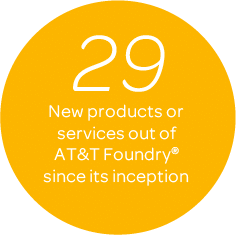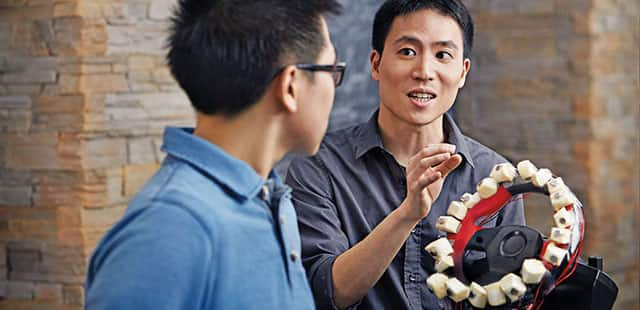We don't ask if, We ask how
Future First
A steering wheel that keeps drivers on course. A process that turns ideas into prototypes in less than a month. Innovation is accelerating our ability to deliver the future first.

The 1,300 scientists and engineers at AT&T Labs spend their lives developing new technologies to help people live better and businesses perform better. And today's ubiquitous wireless connectivity gives us more opportunities to do this than ever before.
So after AT&T rolled out the "It Can Wait" campaign to discourage distracted driving, AT&T Labs researcher Kevin Li (pictured above right) sought ways to help drivers overcome the sensory overload they often experience while on the road. His goal? Create a safer driving environment and reduce the potential for life-threatening accidents.
Kevin realized that while a driver's senses of sound and sight are often overburdened, the sense of touch is largely underutilized while driving. So he applied haptic — from the Greek for "touch" — technology to communicate navigational cues. Kevin developed a haptics-enhanced steering wheel that vibrates to indicate turns. For example, for a left turn, the steering wheel produces a counterclockwise vibration. These vibrations help drivers watch the highway ahead — not their GPS navigation screens.

A team of AT&T and Carnegie Mellon University researchers has built a prototype of the steering wheel. Early user studies suggest that it can help increase the amount of time drivers keep their eyes on the road, and our Labs are continuing to explore using tactile feedback in the steering wheel to convey more than just single directional cues. We hope that in the years to come haptics can be one more powerful weapon in the fight against distracted driving.
Online Exclusive







It's all possible thanks to a new mobile app developed at AT&T Labs. The award-winning AT&T Translator app taps into the power of the AT&T network and the AT&T WatsonSM speech recognition engine to break down language barriers with real-time, accurate translations. AT&T Translator lets people easily translate speech or writing between English, Chinese, French, German, Italian, Japanese and Spanish.
And more new solutions are on the way, as AT&T also lets developers harness AT&T WatsonSM speech recognition with the AT&T Speech API. The cloud-based API basically puts the speech recognition expertise of AT&T WatsonSM into the hands of app developers, who can use it to enhance their own apps with such features as Web and local business search, question and answer, text messaging, voice mail to text … even U-verse programming. It's just one more way we're innovating to bring new possibilities to our own customers and help developers do the same.
With 120 patents to her name, Marian Croak helps lead the innovation push within AT&T. Meanwhile, Abhi Ingle spearheads AT&T's creation of an innovation "ecosystem." Together, they're helping develop creative new solutions to meet our customers' needs and grow our business:
How would you describe AT&T's approach to innovation?
ABHI "We've planted several seeds that have taken root to transform our approach to innovation — AT&T Foundry® innovation centers; alliances with venture capital firms to hear 'fast pitches' from startups with exciting new ideas; and our internal innovation crowdsourcing tool, The Innovation Pipeline (TIP), which lets employees' ideas move from presentation to prototype in just a few months. Add the world-class research at AT&T Labs, and we have the right mix to drive innovation.
"And we match these great assets within AT&T with capabilities outside our walls."
So collaboration is an important part of AT&T's approach?
MARIAN "Absolutely … internally and externally. We're collaborating to develop amazing new applications and services for our customers. And we're building cutting-edge tools to make it easy for developers to integrate our technologies into their apps."
ABHI "We look across the entire ecosystem — whether it's researchers in AT&T Labs, innovation coaches in AT&T Foundry®, developers in a garage or an employee in an AT&T retail store. We engage all those points of view and creative resources, and we pull it all together to accelerate new solutions."
What's coming next?
MARIAN "With initiatives like Fast Pitch, AT&T Foundry® and TIP, we now have proven processes that can help us continue to innovate in the tech arena to bring new solutions to our customers. But we'll apply our innovation approach in other areas, too. So we can use TIP to engage our employees to identify new cost-saving opportunities in our business. Or challenge developers to help us find ways to address the U.S. education crisis. The best is yet to come."



AT&T is on a mission: Transform how we innovate. And collaboration is the unifying theme of our innovation mindset. By working together — with our colleagues and with innovators outside AT&T — we're not only developing new solutions … we're doing it faster than ever. Consider the process we call Fast Pitch:







![]() Self-optimizing network
Self-optimizing network
In a Fast Pitch session at AT&T Foundry® in Israel, Intucell pitched an idea for a self-optimizing network (SON), which detects wireless network overloads and automatically shifts traffic to cell towers with more capacity. After Intucell pitched the idea for SON, we moved the project into the AT&T Foundry®. Within a month we were testing prototypes. Today we're deploying SON across AT&T's network. Based on network data, SON helps us efficiently manage traffic and improves the customer experience by reducing dropped calls by 10 percent.
![]() U-verse Video Bill
U-verse Video Bill
In another Fast Pitch session, video software startup SundaySky introduced a way to offer customers personalized videos explaining their bills. Today, we're providing AT&T U-verse customers with a Video Bill for the first two months of service and any time they change plans. Feedback is positive — 85 percent of U-verse customers who have used Video Bill tell us it's helpful — and we're getting fewer billing-related calls. That's a big win. So we're expanding Video Bill to our wireless customers — a first in the U.S. wireless industry.














